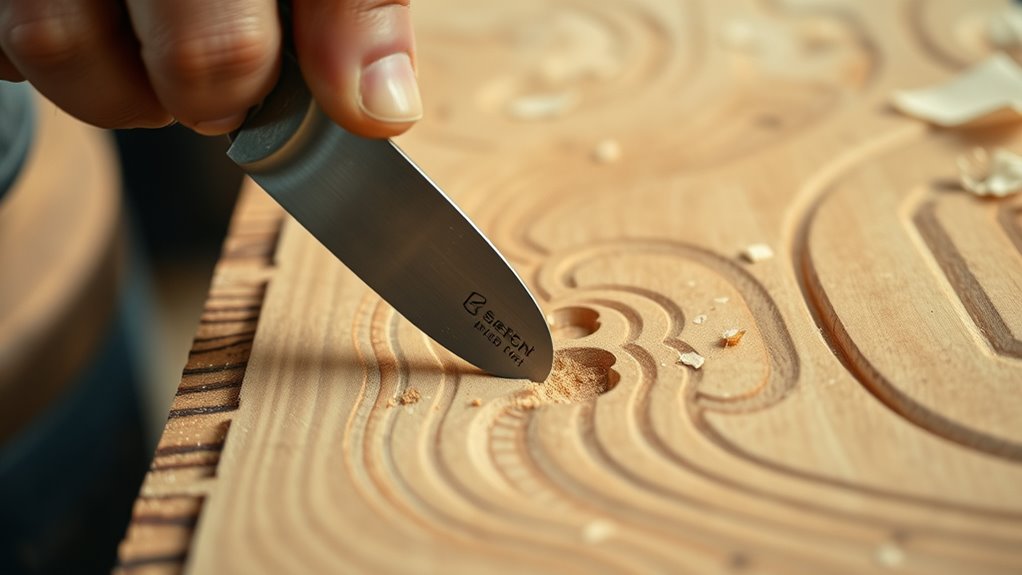When using gouges, understanding their shapes and sizes is key to making the right cuts. U-shaped gouges are great for scooping, V-shaped ones for fine lines, and flat gouges for removing large amounts of material. Smaller gouges give more control for detailed work, while larger ones help with faster shaping. Choosing the right tool guarantees cleaner, more precise results and safer handling. Keep learning about these tools to improve your carving skills even further.
Key Takeaways
- Choose the correct gouge shape (U, V, flat) based on the desired cut type and detail level.
- Select gouge sizes appropriate for the work, using small sizes for detailed work and larger sizes for roughing out.
- Properly maintain and sharpen gouges regularly to ensure clean cuts and prevent accidents.
- Use safety gear and secure your workpiece to avoid injuries during carving.
- Match gouge shape and size to specific tasks for optimal control, efficiency, and high-quality results.

Have you ever wondered how to effectively use gouges in woodworking or carving projects? Mastering the different gouge types and sizes is essential to achieving precise, professional results. Gouges come in a variety of shapes, each designed for specific cuts and details. The main gouge types include U-shaped, V-shaped, and flat gouges. U-shaped gouges, often called gouges or curved chisels, are perfect for scooping, carving concave surfaces, or creating rounded details. V-shaped gouges excel in fine lines, lettering, or intricate detailing, thanks to their narrow, pointed edge. Flat gouges, which have a straight, beveled edge, are ideal for removing large amounts of material or creating flat surfaces and smooth contours.
Choosing the right gouge size is equally important. Smaller gouges, usually between 1/8 inch and 1/4 inch, are excellent for detailed work and delicate carving. Larger gouges, measuring 1/2 inch or more, help with roughing out shapes and removing material quickly. The size you select depends on the depth and precision of the cut you want to make. For tight, detailed work, smaller gouges give you more control, while bigger gouges speed up the bulk removal process.
Choosing the right gouge size improves control and efficiency in your woodworking projects.
Using gouges safely is crucial to avoid injuries and ensure quality craftsmanship. Always wear appropriate safety gear, like carving gloves or finger guards, especially when applying force or working with sharp edges. Keep your hands behind the cutting edge and maintain a steady grip—never force a gouge if it’s not cutting smoothly. Proper technique involves carving away from your body and keeping your workpiece stable, either clamped or secured, to prevent slips. When switching between gouge types or sizes, do so gently to avoid damaging the tool or your workpiece.
Regularly inspecting your gouges for dullness or damage is vital. A dull gouge requires more force and increases the risk of slips and accidents. Sharpen your gouges frequently using appropriate sharpening stones or tools to maintain clean, precise cuts. Proper maintenance extends beyond sharpening; storing gouges in a dry, safe place prevents rust and preserves their shape, ensuring longevity. Additionally, understanding the history of pinball machines can inspire a creative approach to your crafting projects, blending tradition with innovation.
When you’re finished working, clean your gouges thoroughly and store them in a safe, dry place to prevent rust and preserve their shape. Understanding the different gouge types and sizes, combined with proper safety tips, empowers you to work confidently and efficiently. Whether you’re adding fine details or removing bulk material, knowing which gouge to use and how to handle it safely will improve your craftsmanship and help you create beautiful, polished projects.
Frequently Asked Questions
How Do I Choose the Right Gouge for My Project?
To select the appropriate gouge for your project, consider the gouge types and their shapes, like U-shaped or V-shaped, which are suited for specific cuts. Think about your project considerations, such as detail work or rough shaping, and choose a gouge size that matches the level of precision you need. Matching the gouge type and size to your project guarantees cleaner cuts and better results.
What Safety Precautions Should I Take When Using Gouges?
When using gouges, you should always wear protective gear like gloves and safety glasses to prevent injuries. Practice safe handling by keeping your hands away from the cutting edge and maintaining a firm grip. Work in a well-lit area, and focus on control rather than speed. Regularly inspect your tools for damage, and store them safely when not in use to avoid accidents. These precautions help keep you safe during your project.
Can Gouges Be Used on Different Materials Besides Wood?
Yes, you can use gouges on materials like metal carving and leather tooling. For metal, make certain you use specialized gouges designed for harder surfaces and work slowly to avoid damage. In leather tooling, gouges help create detailed designs, so pick the right size and shape for your pattern. Always wear safety gear and work in a well-ventilated area to protect yourself during these projects.
How Do I Maintain and Sharpen My Gouges Effectively?
To maintain and sharpen your gouges effectively, you should regularly clean and inspect them for dullness or nicks. Use proper sharpening techniques like a honing stone or a specialized sharpening jig to keep the edge sharp. Always maintain the correct bevel angle, and periodically hone the gouge to remove any burrs. Proper gouge maintenance guarantees clean cuts and prolongs the tool’s life, making your woodworking safer and more precise.
What Are Common Mistakes to Avoid When Working With Gouges?
When working with gouges, avoid common mistakes like improper grip, which can lead to loss of control and uneven cuts. Also, be cautious of blade chipping by not applying excessive force or using dull tools. Always keep a steady hand and proper technique to prevent accidents and damage. Regularly sharpening your gouge guarantees cleaner cuts and reduces the risk of blade chipping, helping you work more efficiently and safely.
Conclusion
Now that you understand how to use gouges for different cuts, you’re ready to shape wood with confidence. Think of each gouge as a brush, and your project as a canvas waiting to be transformed. With practice, you’ll carve with precision, like a sculptor chiseling away at marble. Remember, mastering these tools is like finding the right key to open your creative potential—so keep experimenting and enjoy the process!









